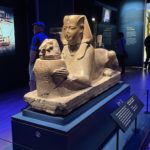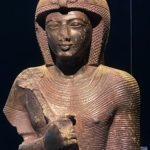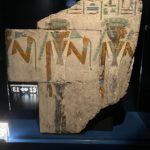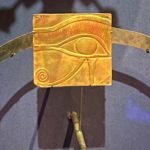
Statue of Ramses II, on display at the Australian Museum. Image © 2023 Scott Rose. All rights reserved.
This week I took a day trip to Sydney to see Ramses & the Gold of the Pharaohs at the Australian Museum and OMGs, it was great! What happens when an Egyptian neo-pagan, otherwise known as a Kemetic practitioner, visits a museum with an exhibition on ancient Egypt?
Let’s just say, multiple levels of reality coalesce to form one, big blissful symphony. I’ll do my best to describe them here. On the surface, I probably look and act like any other museum patron. Be assured however, that internally, I’m combusting! This is my Disneyland. Well, close to it. The only thing better than going to Egypt, of course, is to have Egypt come to you. I am certainly glad this extraordinary slice of the ancient world has come all the way to the Land Down Under. I am undoubtedly one of several thousand giving Ramses a warm welcome.
Ramses & the Gold of the Pharaohs is a must-see exhibit, with pieces not only from the reign of Ramses II (1279–1213 BC) but includes other pharaohs, notable people and events in ancient Egyptian history. Might I mention it’s mercifully air-conditioned and the lighting is superb? There are even a few mummies thrown in for good measure but no people, I’m afraid. I hope cats, lion cubs, crocodiles and dung beetles will suffice. While the exhibit is complete in itself, a good dose of culture is always addictive, and leaves you wanting more. I realised that I might know a thing or two about ancient Egypt, but there’s still so much to learn, see and do. Life goals!
This gallery is just a sampler of what’s on display at Ramses & the Gold of the Pharaohs:
For an intuitive Egyptian pagan, the excitement of Ramses & the Gold of the Pharaohs only touches the surface. There is much, much more going on behind the scenes. If you’re keen to be part of that reality, let’s get mystical.
On the psychic level, my reception with Ramses II occurred well before I got to the museum. During the flight to Sydney, once we climbed to cruising altitude, I allowed myself a deep breath and a moment of relaxation. All the mundane and worldly concerns with getting there drifted into the background. I wasn’t focused on anything in particular and wasn’t expecting or willing anything to happen. I was just chillin’ like a villain, minding my own business. As soon as I closed my eyes, I became aware that my crown chakra was expanding, opening and elevating. I knew I was about to have an experience.
Suddenly, I could sense Ramses’ personality around my energy field, similar to how you can read a person’s energy when they walk into a room. He had an air of calm strength and self-assurance, which he extended to others as a courtesy. He was quite diplomatic and genuine in nature, a man who had learned much about the art of war but even more about the art of peace in his life. While Ramses II is criticised today by Egyptologists for having been boastful and for spreading propaganda during his reign, I could sense none of that in him now. I could tell this was an accomplished, mature, stable and reliable leader and a quite reasonable man.
With a friendly gesture of his hand, Ramses offered me a seat. Hot, black coffee was poured from a silver urn. This coffee ritual was distinctly modern, which is not uncommon when I encounter ancient Egyptian deities, pharaohs and other guides. These beings are not static or stuck in the past but rather, they are here with us in the present, blending the ancient with the modern. We were sitting in a meeting room of sorts, with a large table and chairs. The room felt stately and welcoming, with walls that seemed made of mud brick that had been rendered a pinkish, earthy hue. I could see gardens outside the windows and date palms in the near distance. The place I was in was beautiful, bright and airy. Grand, indeed but not to excess. The coffee smelled rich and delicious, a much-appreciated whiff of salvation after my travels.
I was visiting Ramses in the context of current events unfolding in the Middle East, which is literally on modern Egypt’s doorstep. On the spiritual level, the ancient Egyptians consider themselves to be ambassadors. Not only for ancient Egyptian culture, but for the state of consciousness they represent. That is peace, stability, prosperity, strength and the ideals of a civilised society. Additionally, they have a fierce religious devotion and a commitment to ongoing spiritual growth and development. In the afterlife, these attributes go to the next level in terms of their refinement. That means, as spiritual guides, they foster spiritual growth for all human beings regardless of their belief systems, with an ultimate goal for all human beings to reach god-consciousness. This involves knowing and experiencing yourself as the one, the many and the all, simultaneously. It involves knowing that you are the love that created the universe. If this occurs, if every human being on Earth achieves god-consciousness, we would all lay our weapons down. These qualities are especially needed on Earth at this time, so there is an added importance to the presence of the old gods, or netjeru as well as the ancient Egyptian spiritual guides. Ramses II can certainly be counted among them.
Ramses voiced concern for those effected by terror and violence. His question to me was, what are you doing for peace? It doesn’t mean all of us have to donate 1 million dollars or risk our lives. It can involve peaceful activism in physical reality, it can also involve holding the frequency for peace through meditation and prayer, thereby making a peaceful state of mind more available for others, including our world leaders. Suggestions on how to achieve this can be found here and here.
Thank you, for reading Kemetic Blog. I highly recommend seeing Ramses & the Gold of the Pharaohs. You won’t regret it!

Acknowledgement of African Origin The author of Kemetic Blog acknowledges and respects the African ancestral origins of ancient Egypt and recognises the practice of Kemetic paganism as a modern reflection of Traditional African Religion.
©Scott Rose / Kemetic Blog – All Rights Reserved.



















No Comments